A Report on Literacy and Numeracy Skills in Secondary School
VerifiedAdded on 2023/01/12
|10
|2529
|67
Report
AI Summary
This report examines the significance of literacy and numeracy skills across the curriculum, particularly within the context of secondary education. Part A defines literacy and numeracy and emphasizes their importance for all teachers, not just those in English and Mathematics. It explores how these skills are crucial for academic understanding and student success, referencing relevant literature and research. Part B focuses on a specific secondary school discipline, physics, and identifies the literacy and numeracy demands inherent in its syllabus and teaching materials. The report highlights the specific vocabulary, reading comprehension, and mathematical skills required for success in physics, offering insights into how educators can support student development in these areas. The report emphasizes the need for teachers to understand and address these demands to effectively promote student learning and achievement. It also discusses the importance of educators adapting lesson plans to accommodate the specific learning needs of students.
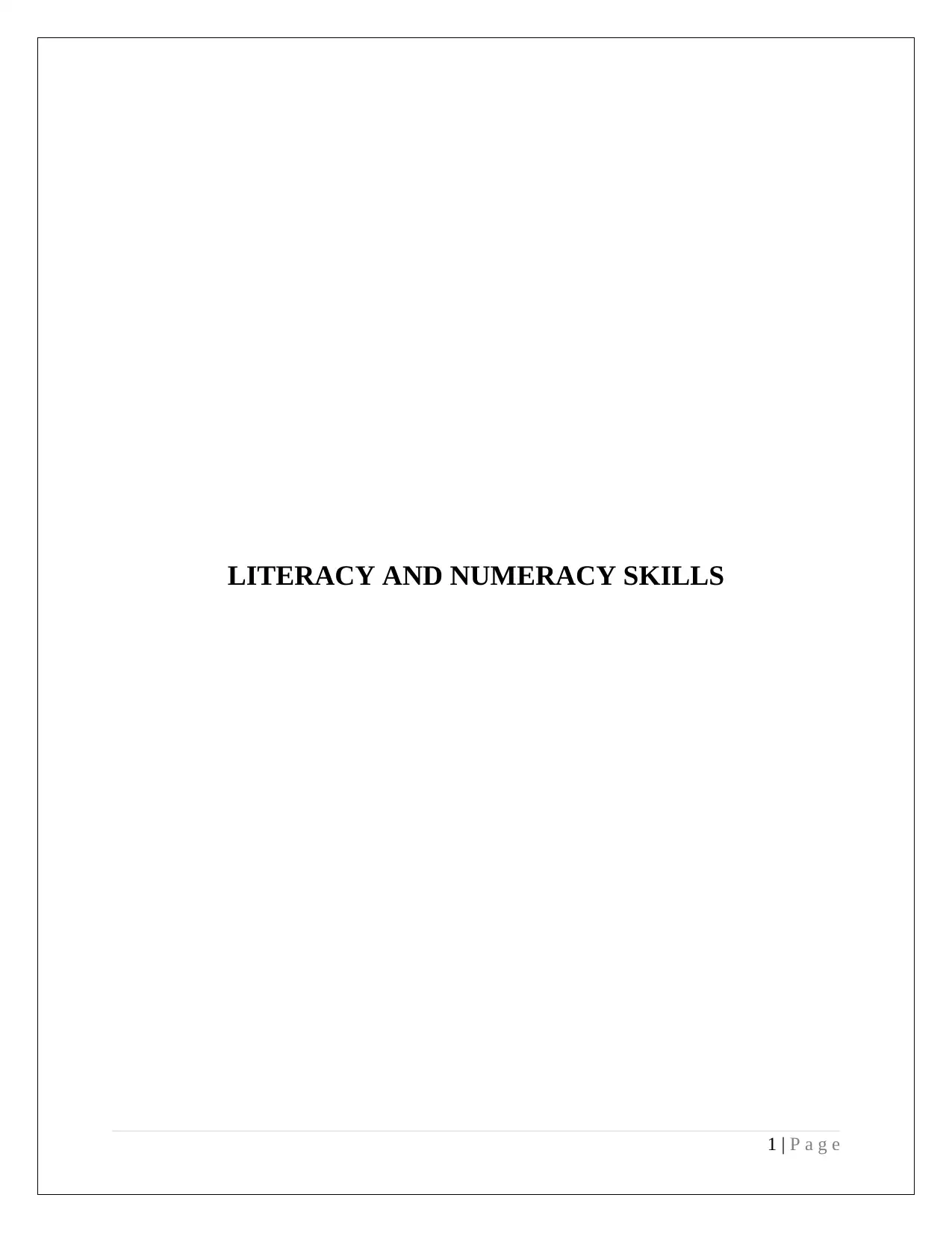
LITERACY AND NUMERACY SKILLS
1 | P a g e
1 | P a g e
Paraphrase This Document
Need a fresh take? Get an instant paraphrase of this document with our AI Paraphraser
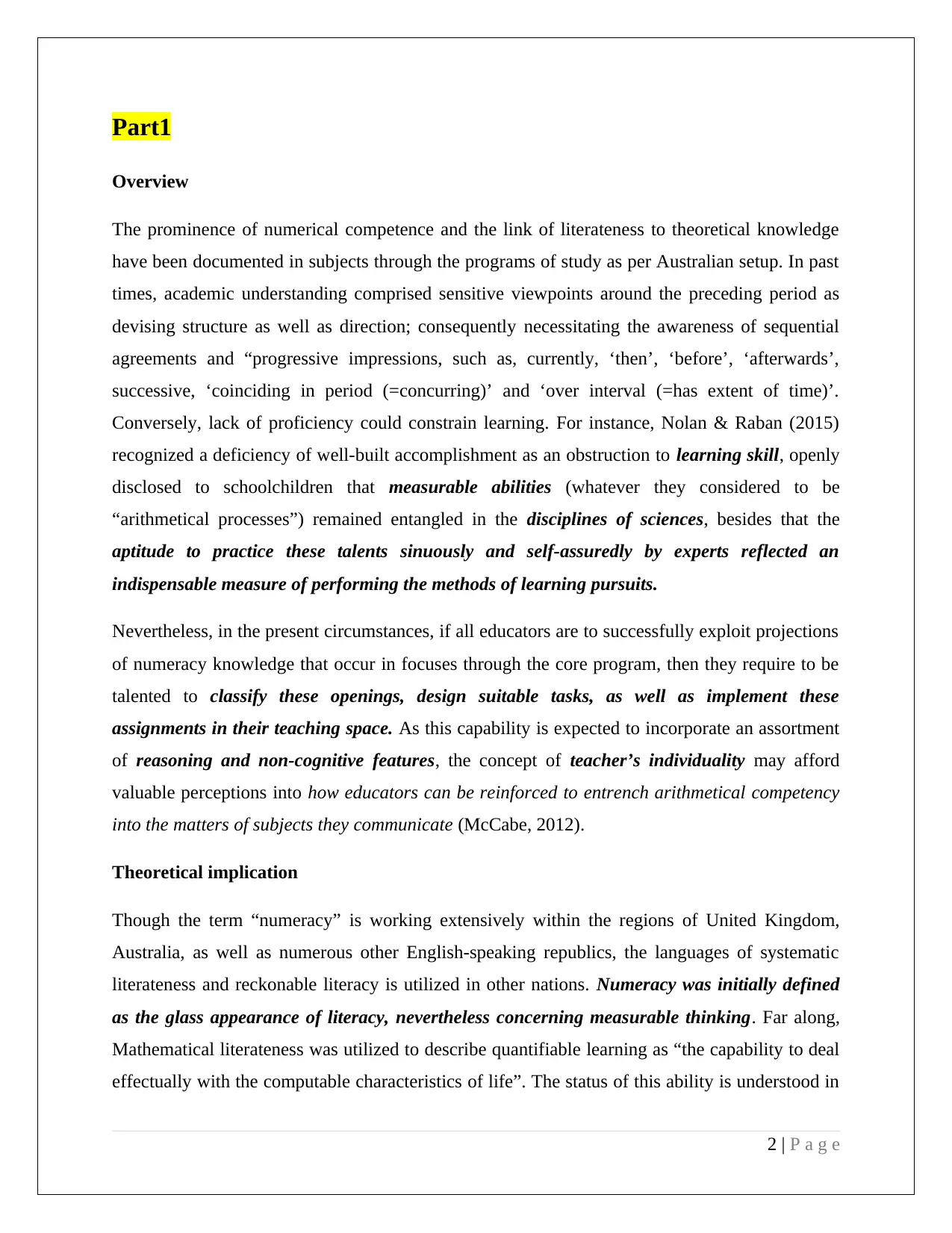
Part1
Overview
The prominence of numerical competence and the link of literateness to theoretical knowledge
have been documented in subjects through the programs of study as per Australian setup. In past
times, academic understanding comprised sensitive viewpoints around the preceding period as
devising structure as well as direction; consequently necessitating the awareness of sequential
agreements and “progressive impressions, such as, currently, ‘then’, ‘before’, ‘afterwards’,
successive, ‘coinciding in period (=concurring)’ and ‘over interval (=has extent of time)’.
Conversely, lack of proficiency could constrain learning. For instance, Nolan & Raban (2015)
recognized a deficiency of well-built accomplishment as an obstruction to learning skill, openly
disclosed to schoolchildren that measurable abilities (whatever they considered to be
“arithmetical processes”) remained entangled in the disciplines of sciences, besides that the
aptitude to practice these talents sinuously and self-assuredly by experts reflected an
indispensable measure of performing the methods of learning pursuits.
Nevertheless, in the present circumstances, if all educators are to successfully exploit projections
of numeracy knowledge that occur in focuses through the core program, then they require to be
talented to classify these openings, design suitable tasks, as well as implement these
assignments in their teaching space. As this capability is expected to incorporate an assortment
of reasoning and non-cognitive features, the concept of teacher’s individuality may afford
valuable perceptions into how educators can be reinforced to entrench arithmetical competency
into the matters of subjects they communicate (McCabe, 2012).
Theoretical implication
Though the term “numeracy” is working extensively within the regions of United Kingdom,
Australia, as well as numerous other English-speaking republics, the languages of systematic
literateness and reckonable literacy is utilized in other nations. Numeracy was initially defined
as the glass appearance of literacy, nevertheless concerning measurable thinking. Far along,
Mathematical literateness was utilized to describe quantifiable learning as “the capability to deal
effectually with the computable characteristics of life”. The status of this ability is understood in
2 | P a g e
Overview
The prominence of numerical competence and the link of literateness to theoretical knowledge
have been documented in subjects through the programs of study as per Australian setup. In past
times, academic understanding comprised sensitive viewpoints around the preceding period as
devising structure as well as direction; consequently necessitating the awareness of sequential
agreements and “progressive impressions, such as, currently, ‘then’, ‘before’, ‘afterwards’,
successive, ‘coinciding in period (=concurring)’ and ‘over interval (=has extent of time)’.
Conversely, lack of proficiency could constrain learning. For instance, Nolan & Raban (2015)
recognized a deficiency of well-built accomplishment as an obstruction to learning skill, openly
disclosed to schoolchildren that measurable abilities (whatever they considered to be
“arithmetical processes”) remained entangled in the disciplines of sciences, besides that the
aptitude to practice these talents sinuously and self-assuredly by experts reflected an
indispensable measure of performing the methods of learning pursuits.
Nevertheless, in the present circumstances, if all educators are to successfully exploit projections
of numeracy knowledge that occur in focuses through the core program, then they require to be
talented to classify these openings, design suitable tasks, as well as implement these
assignments in their teaching space. As this capability is expected to incorporate an assortment
of reasoning and non-cognitive features, the concept of teacher’s individuality may afford
valuable perceptions into how educators can be reinforced to entrench arithmetical competency
into the matters of subjects they communicate (McCabe, 2012).
Theoretical implication
Though the term “numeracy” is working extensively within the regions of United Kingdom,
Australia, as well as numerous other English-speaking republics, the languages of systematic
literateness and reckonable literacy is utilized in other nations. Numeracy was initially defined
as the glass appearance of literacy, nevertheless concerning measurable thinking. Far along,
Mathematical literateness was utilized to describe quantifiable learning as “the capability to deal
effectually with the computable characteristics of life”. The status of this ability is understood in
2 | P a g e
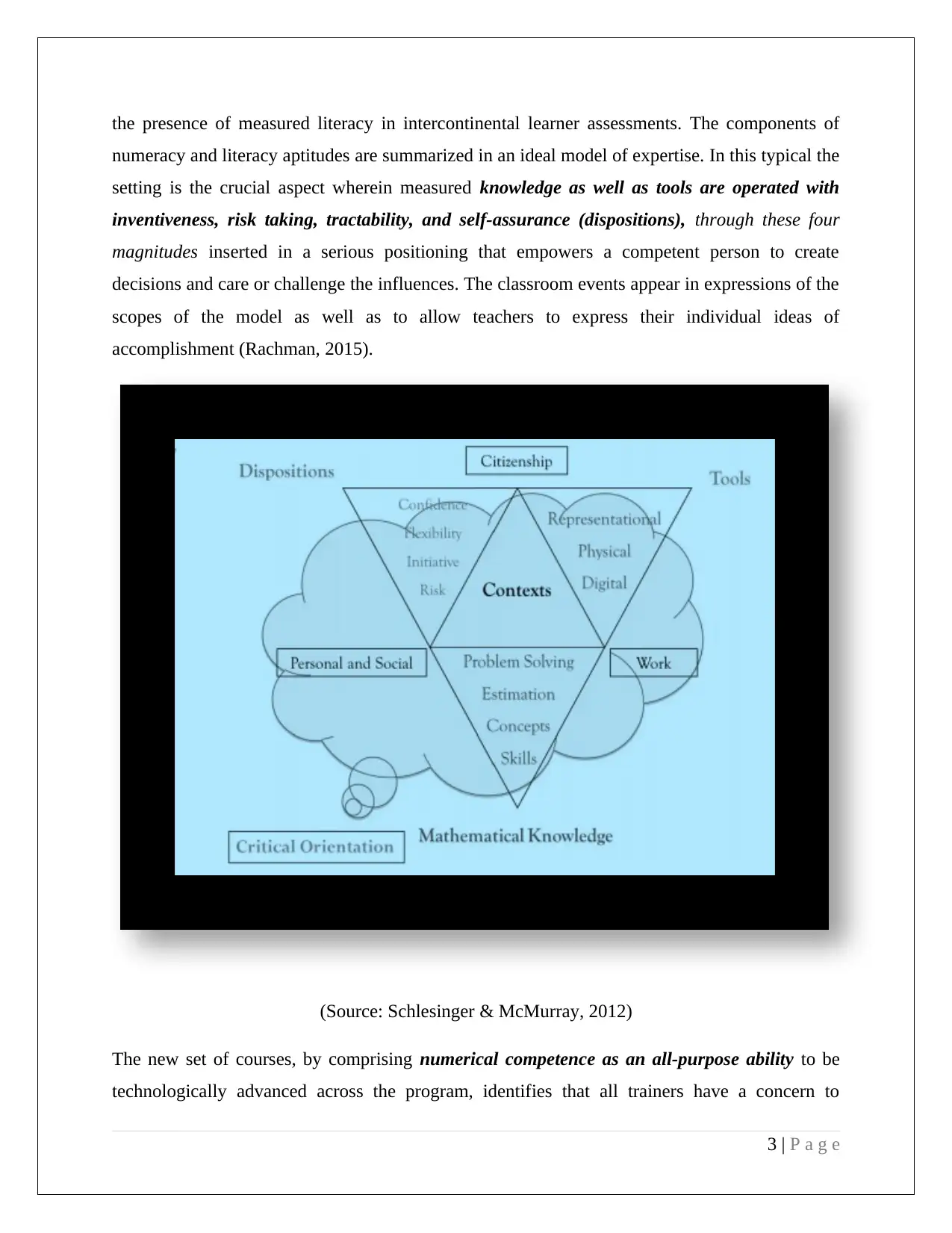
the presence of measured literacy in intercontinental learner assessments. The components of
numeracy and literacy aptitudes are summarized in an ideal model of expertise. In this typical the
setting is the crucial aspect wherein measured knowledge as well as tools are operated with
inventiveness, risk taking, tractability, and self-assurance (dispositions), through these four
magnitudes inserted in a serious positioning that empowers a competent person to create
decisions and care or challenge the influences. The classroom events appear in expressions of the
scopes of the model as well as to allow teachers to express their individual ideas of
accomplishment (Rachman, 2015).
(Source: Schlesinger & McMurray, 2012)
The new set of courses, by comprising numerical competence as an all-purpose ability to be
technologically advanced across the program, identifies that all trainers have a concern to
3 | P a g e
numeracy and literacy aptitudes are summarized in an ideal model of expertise. In this typical the
setting is the crucial aspect wherein measured knowledge as well as tools are operated with
inventiveness, risk taking, tractability, and self-assurance (dispositions), through these four
magnitudes inserted in a serious positioning that empowers a competent person to create
decisions and care or challenge the influences. The classroom events appear in expressions of the
scopes of the model as well as to allow teachers to express their individual ideas of
accomplishment (Rachman, 2015).
(Source: Schlesinger & McMurray, 2012)
The new set of courses, by comprising numerical competence as an all-purpose ability to be
technologically advanced across the program, identifies that all trainers have a concern to
3 | P a g e
⊘ This is a preview!⊘
Do you want full access?
Subscribe today to unlock all pages.

Trusted by 1+ million students worldwide
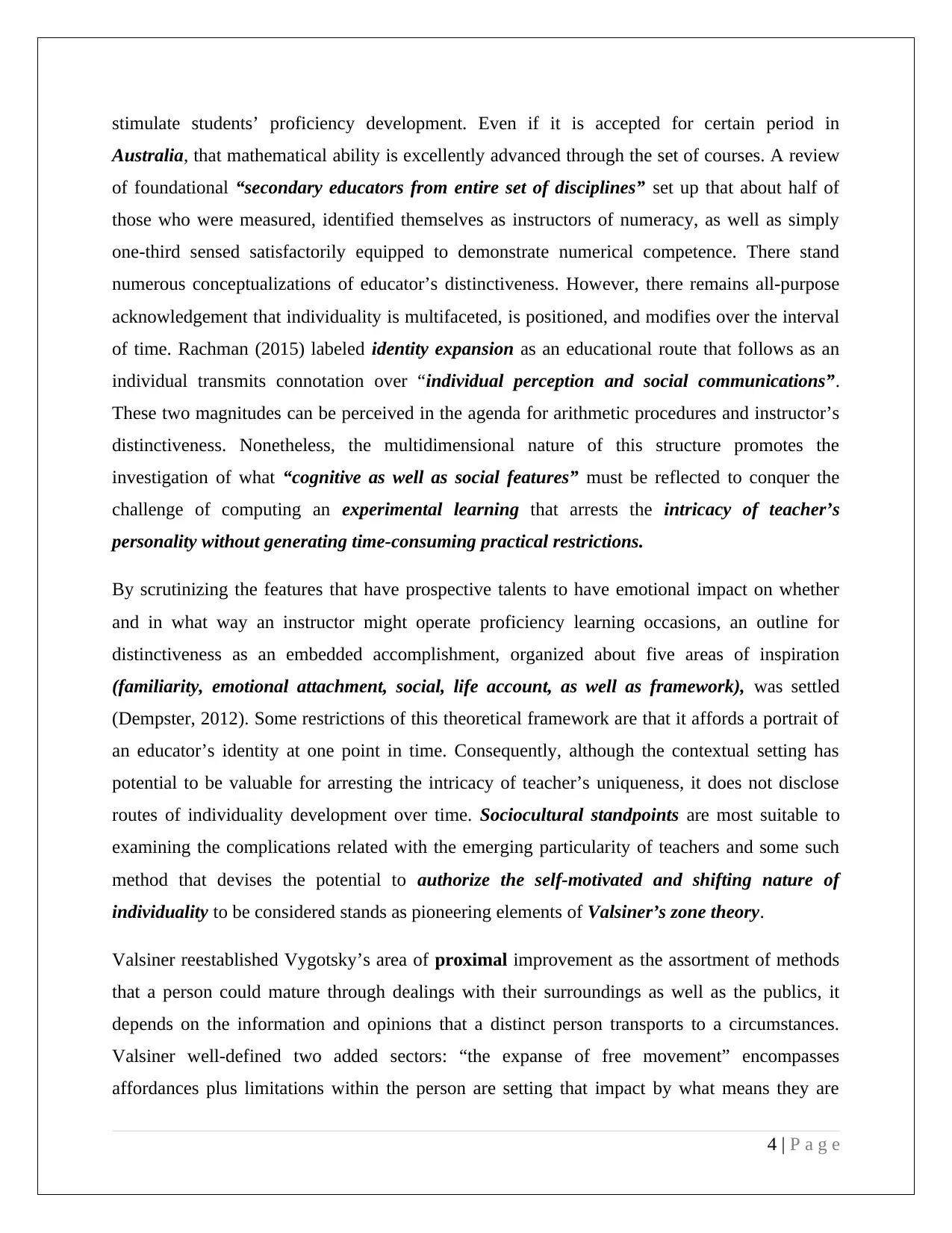
stimulate students’ proficiency development. Even if it is accepted for certain period in
Australia, that mathematical ability is excellently advanced through the set of courses. A review
of foundational “secondary educators from entire set of disciplines” set up that about half of
those who were measured, identified themselves as instructors of numeracy, as well as simply
one-third sensed satisfactorily equipped to demonstrate numerical competence. There stand
numerous conceptualizations of educator’s distinctiveness. However, there remains all-purpose
acknowledgement that individuality is multifaceted, is positioned, and modifies over the interval
of time. Rachman (2015) labeled identity expansion as an educational route that follows as an
individual transmits connotation over “individual perception and social communications”.
These two magnitudes can be perceived in the agenda for arithmetic procedures and instructor’s
distinctiveness. Nonetheless, the multidimensional nature of this structure promotes the
investigation of what “cognitive as well as social features” must be reflected to conquer the
challenge of computing an experimental learning that arrests the intricacy of teacher’s
personality without generating time-consuming practical restrictions.
By scrutinizing the features that have prospective talents to have emotional impact on whether
and in what way an instructor might operate proficiency learning occasions, an outline for
distinctiveness as an embedded accomplishment, organized about five areas of inspiration
(familiarity, emotional attachment, social, life account, as well as framework), was settled
(Dempster, 2012). Some restrictions of this theoretical framework are that it affords a portrait of
an educator’s identity at one point in time. Consequently, although the contextual setting has
potential to be valuable for arresting the intricacy of teacher’s uniqueness, it does not disclose
routes of individuality development over time. Sociocultural standpoints are most suitable to
examining the complications related with the emerging particularity of teachers and some such
method that devises the potential to authorize the self-motivated and shifting nature of
individuality to be considered stands as pioneering elements of Valsiner’s zone theory.
Valsiner reestablished Vygotsky’s area of proximal improvement as the assortment of methods
that a person could mature through dealings with their surroundings as well as the publics, it
depends on the information and opinions that a distinct person transports to a circumstances.
Valsiner well-defined two added sectors: “the expanse of free movement” encompasses
affordances plus limitations within the person are setting that impact by what means they are
4 | P a g e
Australia, that mathematical ability is excellently advanced through the set of courses. A review
of foundational “secondary educators from entire set of disciplines” set up that about half of
those who were measured, identified themselves as instructors of numeracy, as well as simply
one-third sensed satisfactorily equipped to demonstrate numerical competence. There stand
numerous conceptualizations of educator’s distinctiveness. However, there remains all-purpose
acknowledgement that individuality is multifaceted, is positioned, and modifies over the interval
of time. Rachman (2015) labeled identity expansion as an educational route that follows as an
individual transmits connotation over “individual perception and social communications”.
These two magnitudes can be perceived in the agenda for arithmetic procedures and instructor’s
distinctiveness. Nonetheless, the multidimensional nature of this structure promotes the
investigation of what “cognitive as well as social features” must be reflected to conquer the
challenge of computing an experimental learning that arrests the intricacy of teacher’s
personality without generating time-consuming practical restrictions.
By scrutinizing the features that have prospective talents to have emotional impact on whether
and in what way an instructor might operate proficiency learning occasions, an outline for
distinctiveness as an embedded accomplishment, organized about five areas of inspiration
(familiarity, emotional attachment, social, life account, as well as framework), was settled
(Dempster, 2012). Some restrictions of this theoretical framework are that it affords a portrait of
an educator’s identity at one point in time. Consequently, although the contextual setting has
potential to be valuable for arresting the intricacy of teacher’s uniqueness, it does not disclose
routes of individuality development over time. Sociocultural standpoints are most suitable to
examining the complications related with the emerging particularity of teachers and some such
method that devises the potential to authorize the self-motivated and shifting nature of
individuality to be considered stands as pioneering elements of Valsiner’s zone theory.
Valsiner reestablished Vygotsky’s area of proximal improvement as the assortment of methods
that a person could mature through dealings with their surroundings as well as the publics, it
depends on the information and opinions that a distinct person transports to a circumstances.
Valsiner well-defined two added sectors: “the expanse of free movement” encompasses
affordances plus limitations within the person are setting that impact by what means they are
4 | P a g e
Paraphrase This Document
Need a fresh take? Get an instant paraphrase of this document with our AI Paraphraser
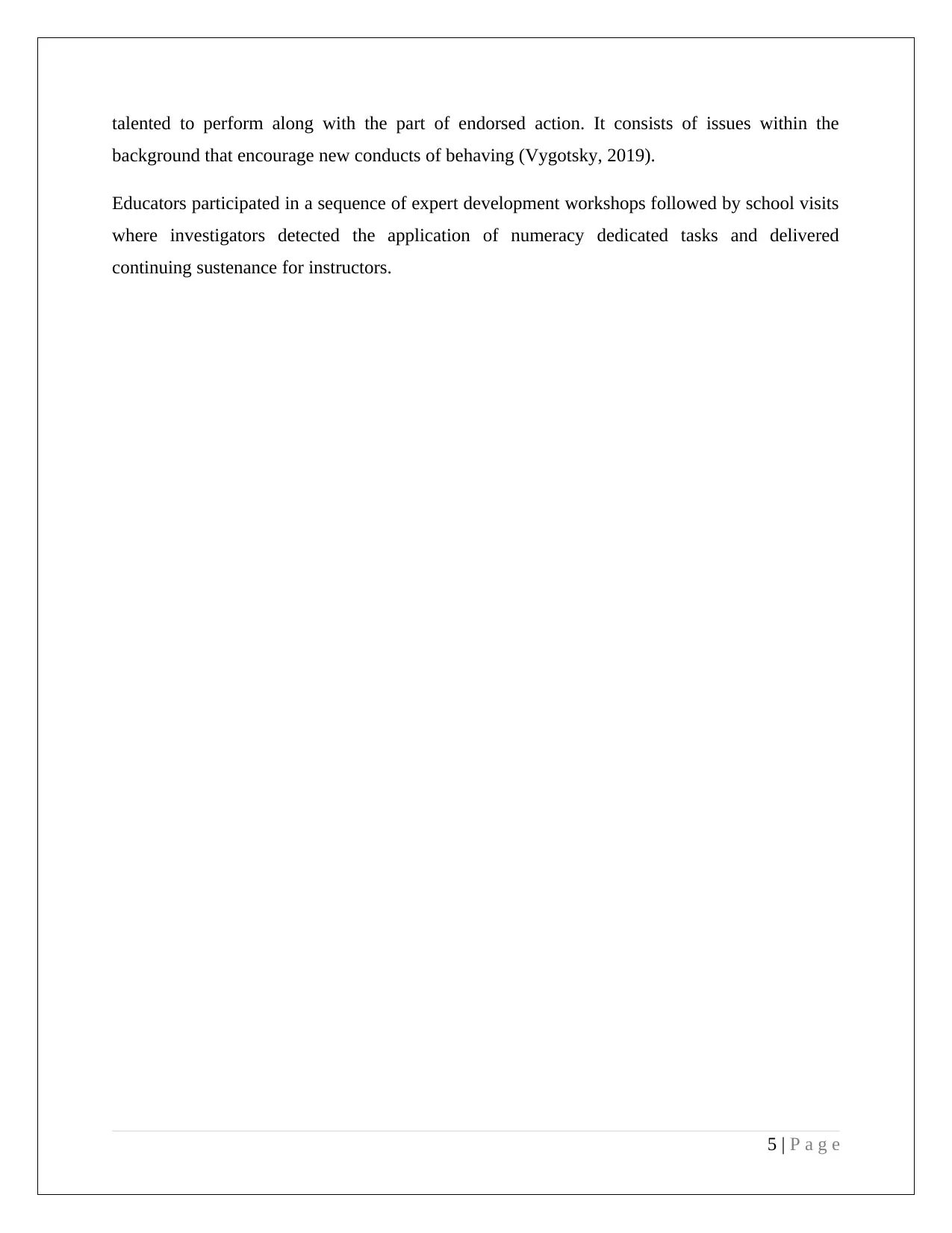
talented to perform along with the part of endorsed action. It consists of issues within the
background that encourage new conducts of behaving (Vygotsky, 2019).
Educators participated in a sequence of expert development workshops followed by school visits
where investigators detected the application of numeracy dedicated tasks and delivered
continuing sustenance for instructors.
5 | P a g e
background that encourage new conducts of behaving (Vygotsky, 2019).
Educators participated in a sequence of expert development workshops followed by school visits
where investigators detected the application of numeracy dedicated tasks and delivered
continuing sustenance for instructors.
5 | P a g e
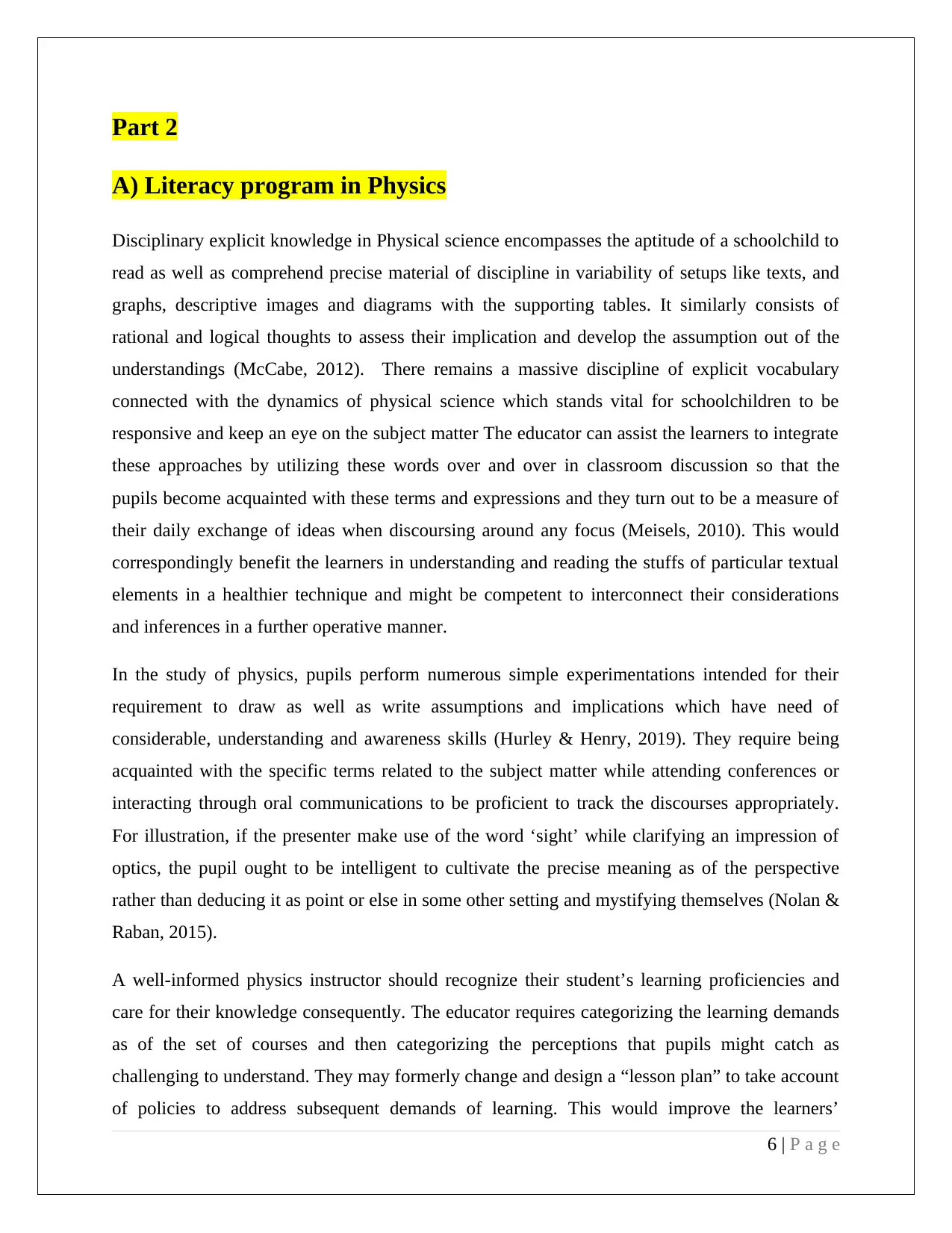
Part 2
A) Literacy program in Physics
Disciplinary explicit knowledge in Physical science encompasses the aptitude of a schoolchild to
read as well as comprehend precise material of discipline in variability of setups like texts, and
graphs, descriptive images and diagrams with the supporting tables. It similarly consists of
rational and logical thoughts to assess their implication and develop the assumption out of the
understandings (McCabe, 2012). There remains a massive discipline of explicit vocabulary
connected with the dynamics of physical science which stands vital for schoolchildren to be
responsive and keep an eye on the subject matter The educator can assist the learners to integrate
these approaches by utilizing these words over and over in classroom discussion so that the
pupils become acquainted with these terms and expressions and they turn out to be a measure of
their daily exchange of ideas when discoursing around any focus (Meisels, 2010). This would
correspondingly benefit the learners in understanding and reading the stuffs of particular textual
elements in a healthier technique and might be competent to interconnect their considerations
and inferences in a further operative manner.
In the study of physics, pupils perform numerous simple experimentations intended for their
requirement to draw as well as write assumptions and implications which have need of
considerable, understanding and awareness skills (Hurley & Henry, 2019). They require being
acquainted with the specific terms related to the subject matter while attending conferences or
interacting through oral communications to be proficient to track the discourses appropriately.
For illustration, if the presenter make use of the word ‘sight’ while clarifying an impression of
optics, the pupil ought to be intelligent to cultivate the precise meaning as of the perspective
rather than deducing it as point or else in some other setting and mystifying themselves (Nolan &
Raban, 2015).
A well-informed physics instructor should recognize their student’s learning proficiencies and
care for their knowledge consequently. The educator requires categorizing the learning demands
as of the set of courses and then categorizing the perceptions that pupils might catch as
challenging to understand. They may formerly change and design a “lesson plan” to take account
of policies to address subsequent demands of learning. This would improve the learners’
6 | P a g e
A) Literacy program in Physics
Disciplinary explicit knowledge in Physical science encompasses the aptitude of a schoolchild to
read as well as comprehend precise material of discipline in variability of setups like texts, and
graphs, descriptive images and diagrams with the supporting tables. It similarly consists of
rational and logical thoughts to assess their implication and develop the assumption out of the
understandings (McCabe, 2012). There remains a massive discipline of explicit vocabulary
connected with the dynamics of physical science which stands vital for schoolchildren to be
responsive and keep an eye on the subject matter The educator can assist the learners to integrate
these approaches by utilizing these words over and over in classroom discussion so that the
pupils become acquainted with these terms and expressions and they turn out to be a measure of
their daily exchange of ideas when discoursing around any focus (Meisels, 2010). This would
correspondingly benefit the learners in understanding and reading the stuffs of particular textual
elements in a healthier technique and might be competent to interconnect their considerations
and inferences in a further operative manner.
In the study of physics, pupils perform numerous simple experimentations intended for their
requirement to draw as well as write assumptions and implications which have need of
considerable, understanding and awareness skills (Hurley & Henry, 2019). They require being
acquainted with the specific terms related to the subject matter while attending conferences or
interacting through oral communications to be proficient to track the discourses appropriately.
For illustration, if the presenter make use of the word ‘sight’ while clarifying an impression of
optics, the pupil ought to be intelligent to cultivate the precise meaning as of the perspective
rather than deducing it as point or else in some other setting and mystifying themselves (Nolan &
Raban, 2015).
A well-informed physics instructor should recognize their student’s learning proficiencies and
care for their knowledge consequently. The educator requires categorizing the learning demands
as of the set of courses and then categorizing the perceptions that pupils might catch as
challenging to understand. They may formerly change and design a “lesson plan” to take account
of policies to address subsequent demands of learning. This would improve the learners’
6 | P a g e
⊘ This is a preview!⊘
Do you want full access?
Subscribe today to unlock all pages.

Trusted by 1+ million students worldwide
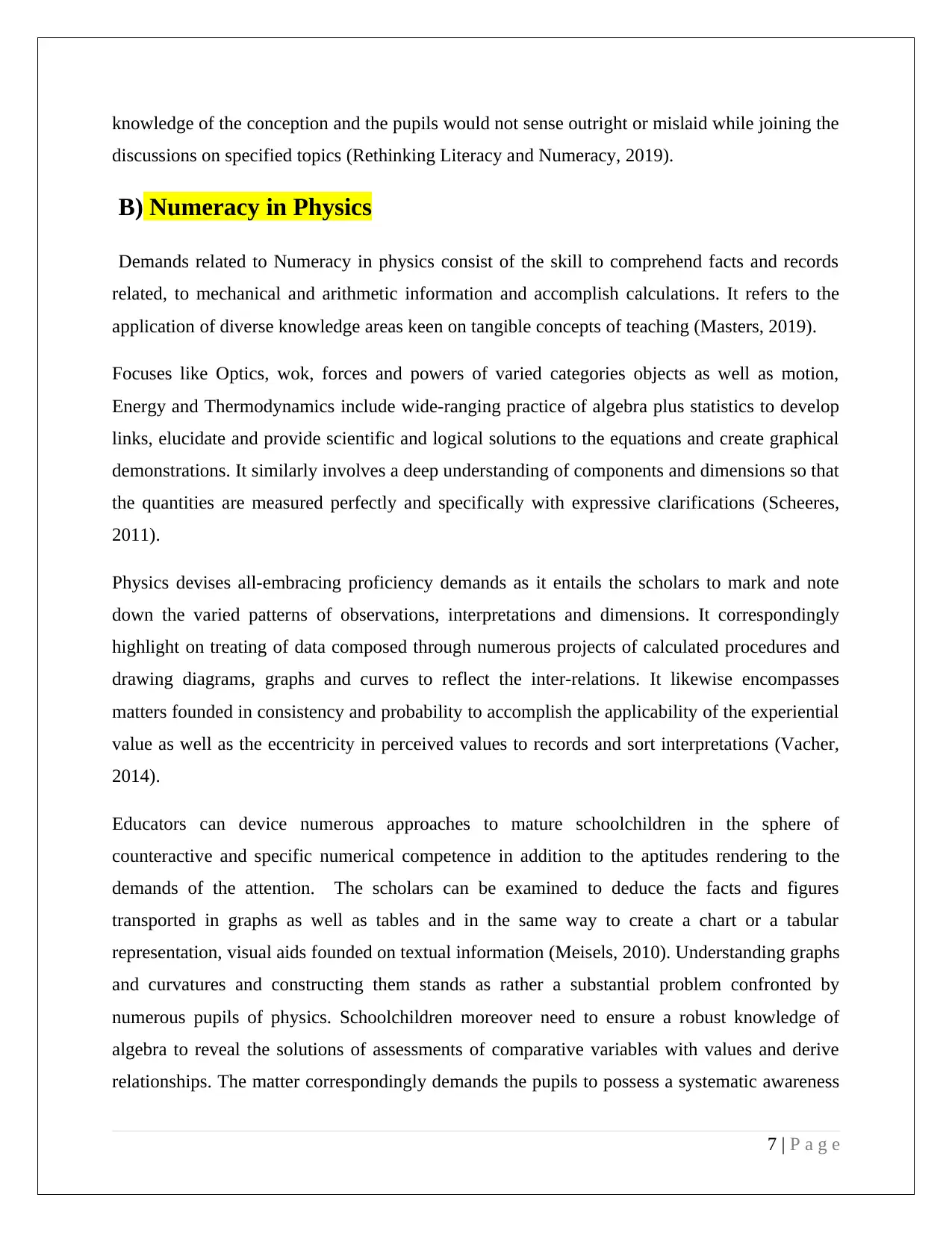
knowledge of the conception and the pupils would not sense outright or mislaid while joining the
discussions on specified topics (Rethinking Literacy and Numeracy, 2019).
B) Numeracy in Physics
Demands related to Numeracy in physics consist of the skill to comprehend facts and records
related, to mechanical and arithmetic information and accomplish calculations. It refers to the
application of diverse knowledge areas keen on tangible concepts of teaching (Masters, 2019).
Focuses like Optics, wok, forces and powers of varied categories objects as well as motion,
Energy and Thermodynamics include wide-ranging practice of algebra plus statistics to develop
links, elucidate and provide scientific and logical solutions to the equations and create graphical
demonstrations. It similarly involves a deep understanding of components and dimensions so that
the quantities are measured perfectly and specifically with expressive clarifications (Scheeres,
2011).
Physics devises all-embracing proficiency demands as it entails the scholars to mark and note
down the varied patterns of observations, interpretations and dimensions. It correspondingly
highlight on treating of data composed through numerous projects of calculated procedures and
drawing diagrams, graphs and curves to reflect the inter-relations. It likewise encompasses
matters founded in consistency and probability to accomplish the applicability of the experiential
value as well as the eccentricity in perceived values to records and sort interpretations (Vacher,
2014).
Educators can device numerous approaches to mature schoolchildren in the sphere of
counteractive and specific numerical competence in addition to the aptitudes rendering to the
demands of the attention. The scholars can be examined to deduce the facts and figures
transported in graphs as well as tables and in the same way to create a chart or a tabular
representation, visual aids founded on textual information (Meisels, 2010). Understanding graphs
and curvatures and constructing them stands as rather a substantial problem confronted by
numerous pupils of physics. Schoolchildren moreover need to ensure a robust knowledge of
algebra to reveal the solutions of assessments of comparative variables with values and derive
relationships. The matter correspondingly demands the pupils to possess a systematic awareness
7 | P a g e
discussions on specified topics (Rethinking Literacy and Numeracy, 2019).
B) Numeracy in Physics
Demands related to Numeracy in physics consist of the skill to comprehend facts and records
related, to mechanical and arithmetic information and accomplish calculations. It refers to the
application of diverse knowledge areas keen on tangible concepts of teaching (Masters, 2019).
Focuses like Optics, wok, forces and powers of varied categories objects as well as motion,
Energy and Thermodynamics include wide-ranging practice of algebra plus statistics to develop
links, elucidate and provide scientific and logical solutions to the equations and create graphical
demonstrations. It similarly involves a deep understanding of components and dimensions so that
the quantities are measured perfectly and specifically with expressive clarifications (Scheeres,
2011).
Physics devises all-embracing proficiency demands as it entails the scholars to mark and note
down the varied patterns of observations, interpretations and dimensions. It correspondingly
highlight on treating of data composed through numerous projects of calculated procedures and
drawing diagrams, graphs and curves to reflect the inter-relations. It likewise encompasses
matters founded in consistency and probability to accomplish the applicability of the experiential
value as well as the eccentricity in perceived values to records and sort interpretations (Vacher,
2014).
Educators can device numerous approaches to mature schoolchildren in the sphere of
counteractive and specific numerical competence in addition to the aptitudes rendering to the
demands of the attention. The scholars can be examined to deduce the facts and figures
transported in graphs as well as tables and in the same way to create a chart or a tabular
representation, visual aids founded on textual information (Meisels, 2010). Understanding graphs
and curvatures and constructing them stands as rather a substantial problem confronted by
numerous pupils of physics. Schoolchildren moreover need to ensure a robust knowledge of
algebra to reveal the solutions of assessments of comparative variables with values and derive
relationships. The matter correspondingly demands the pupils to possess a systematic awareness
7 | P a g e
Paraphrase This Document
Need a fresh take? Get an instant paraphrase of this document with our AI Paraphraser
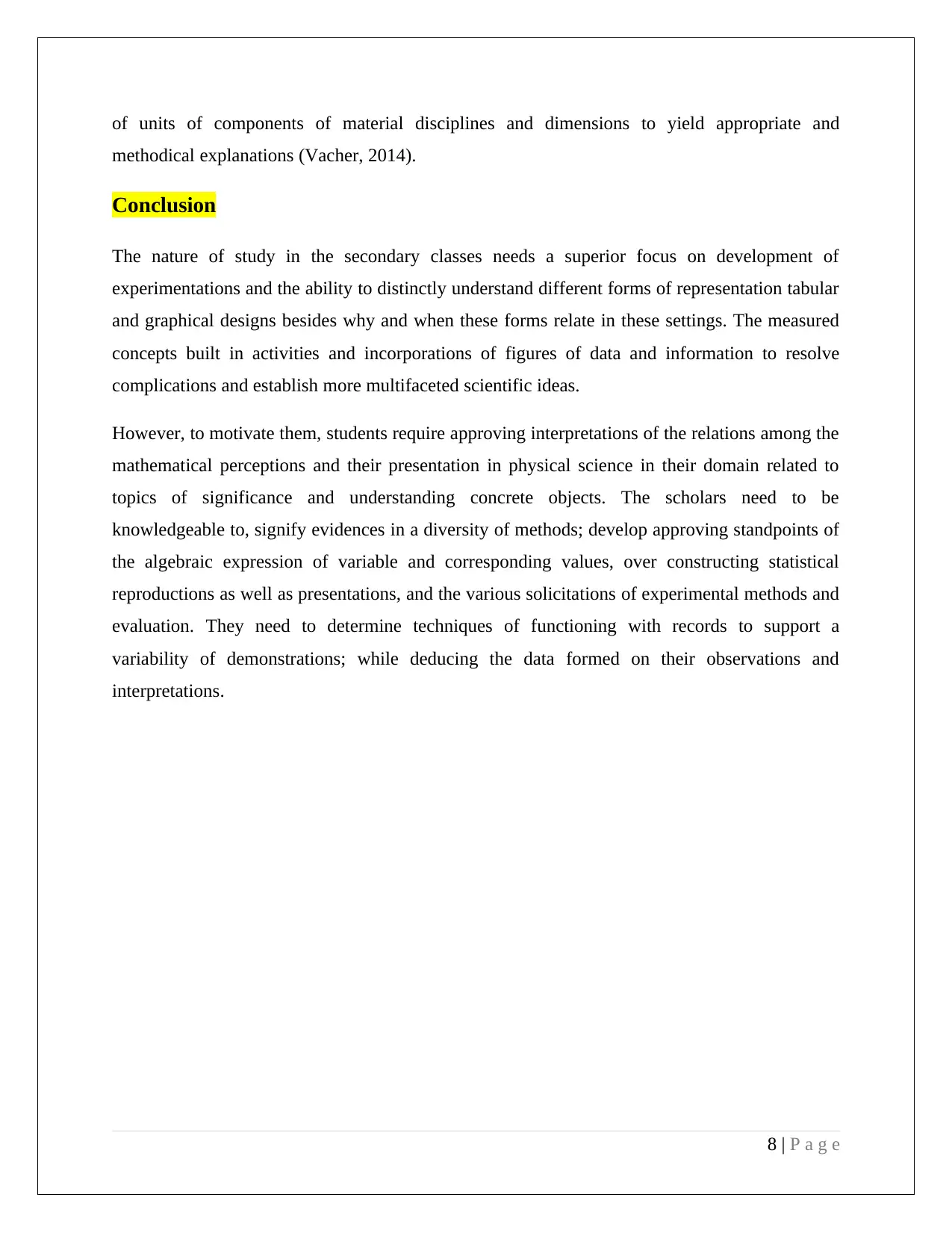
of units of components of material disciplines and dimensions to yield appropriate and
methodical explanations (Vacher, 2014).
Conclusion
The nature of study in the secondary classes needs a superior focus on development of
experimentations and the ability to distinctly understand different forms of representation tabular
and graphical designs besides why and when these forms relate in these settings. The measured
concepts built in activities and incorporations of figures of data and information to resolve
complications and establish more multifaceted scientific ideas.
However, to motivate them, students require approving interpretations of the relations among the
mathematical perceptions and their presentation in physical science in their domain related to
topics of significance and understanding concrete objects. The scholars need to be
knowledgeable to, signify evidences in a diversity of methods; develop approving standpoints of
the algebraic expression of variable and corresponding values, over constructing statistical
reproductions as well as presentations, and the various solicitations of experimental methods and
evaluation. They need to determine techniques of functioning with records to support a
variability of demonstrations; while deducing the data formed on their observations and
interpretations.
8 | P a g e
methodical explanations (Vacher, 2014).
Conclusion
The nature of study in the secondary classes needs a superior focus on development of
experimentations and the ability to distinctly understand different forms of representation tabular
and graphical designs besides why and when these forms relate in these settings. The measured
concepts built in activities and incorporations of figures of data and information to resolve
complications and establish more multifaceted scientific ideas.
However, to motivate them, students require approving interpretations of the relations among the
mathematical perceptions and their presentation in physical science in their domain related to
topics of significance and understanding concrete objects. The scholars need to be
knowledgeable to, signify evidences in a diversity of methods; develop approving standpoints of
the algebraic expression of variable and corresponding values, over constructing statistical
reproductions as well as presentations, and the various solicitations of experimental methods and
evaluation. They need to determine techniques of functioning with records to support a
variability of demonstrations; while deducing the data formed on their observations and
interpretations.
8 | P a g e
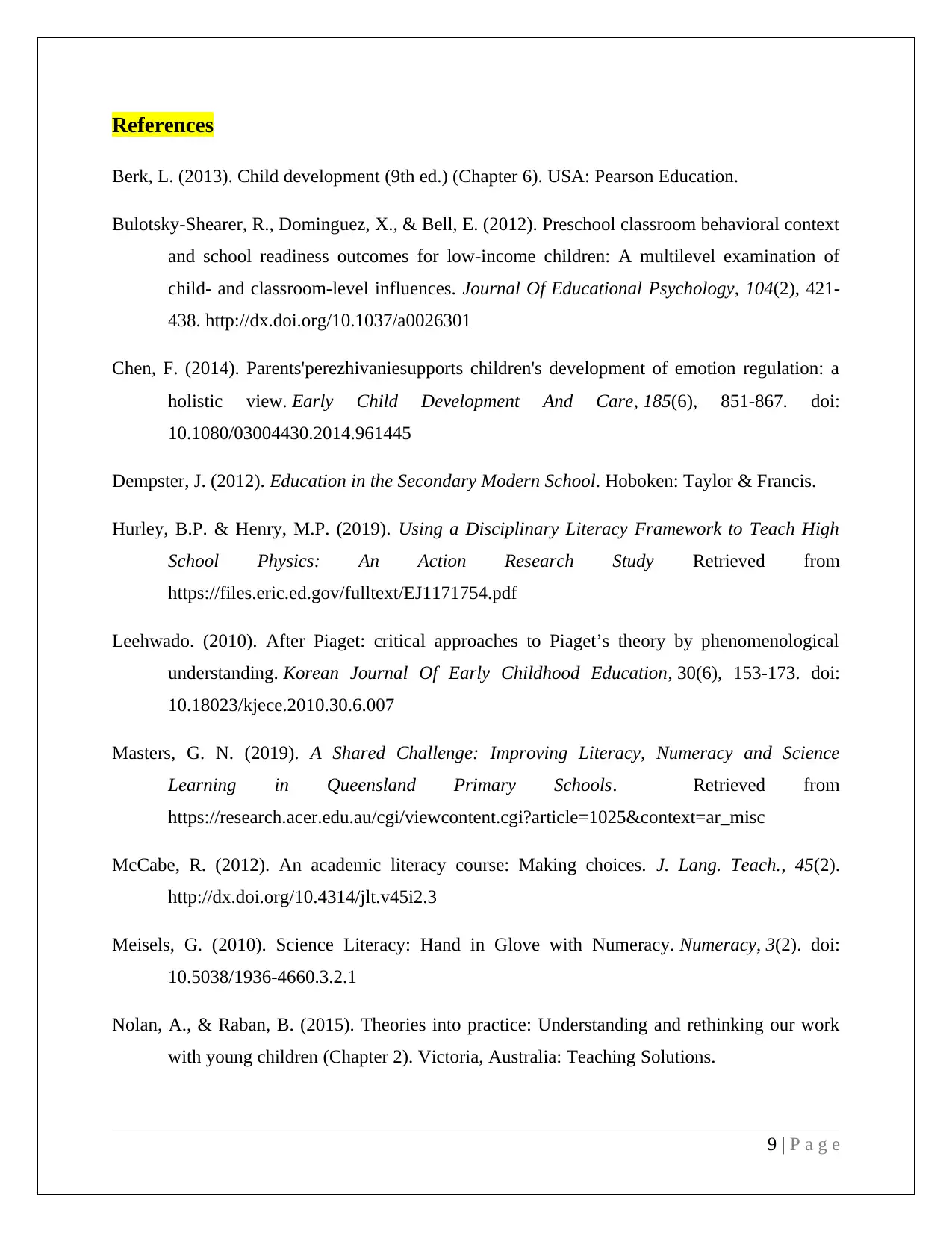
References
Berk, L. (2013). Child development (9th ed.) (Chapter 6). USA: Pearson Education.
Bulotsky-Shearer, R., Dominguez, X., & Bell, E. (2012). Preschool classroom behavioral context
and school readiness outcomes for low-income children: A multilevel examination of
child- and classroom-level influences. Journal Of Educational Psychology, 104(2), 421-
438. http://dx.doi.org/10.1037/a0026301
Chen, F. (2014). Parents'perezhivaniesupports children's development of emotion regulation: a
holistic view. Early Child Development And Care, 185(6), 851-867. doi:
10.1080/03004430.2014.961445
Dempster, J. (2012). Education in the Secondary Modern School. Hoboken: Taylor & Francis.
Hurley, B.P. & Henry, M.P. (2019). Using a Disciplinary Literacy Framework to Teach High
School Physics: An Action Research Study Retrieved from
https://files.eric.ed.gov/fulltext/EJ1171754.pdf
Leehwado. (2010). After Piaget: critical approaches to Piaget’s theory by phenomenological
understanding. Korean Journal Of Early Childhood Education, 30(6), 153-173. doi:
10.18023/kjece.2010.30.6.007
Masters, G. N. (2019). A Shared Challenge: Improving Literacy, Numeracy and Science
Learning in Queensland Primary Schools. Retrieved from
https://research.acer.edu.au/cgi/viewcontent.cgi?article=1025&context=ar_misc
McCabe, R. (2012). An academic literacy course: Making choices. J. Lang. Teach., 45(2).
http://dx.doi.org/10.4314/jlt.v45i2.3
Meisels, G. (2010). Science Literacy: Hand in Glove with Numeracy. Numeracy, 3(2). doi:
10.5038/1936-4660.3.2.1
Nolan, A., & Raban, B. (2015). Theories into practice: Understanding and rethinking our work
with young children (Chapter 2). Victoria, Australia: Teaching Solutions.
9 | P a g e
Berk, L. (2013). Child development (9th ed.) (Chapter 6). USA: Pearson Education.
Bulotsky-Shearer, R., Dominguez, X., & Bell, E. (2012). Preschool classroom behavioral context
and school readiness outcomes for low-income children: A multilevel examination of
child- and classroom-level influences. Journal Of Educational Psychology, 104(2), 421-
438. http://dx.doi.org/10.1037/a0026301
Chen, F. (2014). Parents'perezhivaniesupports children's development of emotion regulation: a
holistic view. Early Child Development And Care, 185(6), 851-867. doi:
10.1080/03004430.2014.961445
Dempster, J. (2012). Education in the Secondary Modern School. Hoboken: Taylor & Francis.
Hurley, B.P. & Henry, M.P. (2019). Using a Disciplinary Literacy Framework to Teach High
School Physics: An Action Research Study Retrieved from
https://files.eric.ed.gov/fulltext/EJ1171754.pdf
Leehwado. (2010). After Piaget: critical approaches to Piaget’s theory by phenomenological
understanding. Korean Journal Of Early Childhood Education, 30(6), 153-173. doi:
10.18023/kjece.2010.30.6.007
Masters, G. N. (2019). A Shared Challenge: Improving Literacy, Numeracy and Science
Learning in Queensland Primary Schools. Retrieved from
https://research.acer.edu.au/cgi/viewcontent.cgi?article=1025&context=ar_misc
McCabe, R. (2012). An academic literacy course: Making choices. J. Lang. Teach., 45(2).
http://dx.doi.org/10.4314/jlt.v45i2.3
Meisels, G. (2010). Science Literacy: Hand in Glove with Numeracy. Numeracy, 3(2). doi:
10.5038/1936-4660.3.2.1
Nolan, A., & Raban, B. (2015). Theories into practice: Understanding and rethinking our work
with young children (Chapter 2). Victoria, Australia: Teaching Solutions.
9 | P a g e
⊘ This is a preview!⊘
Do you want full access?
Subscribe today to unlock all pages.

Trusted by 1+ million students worldwide
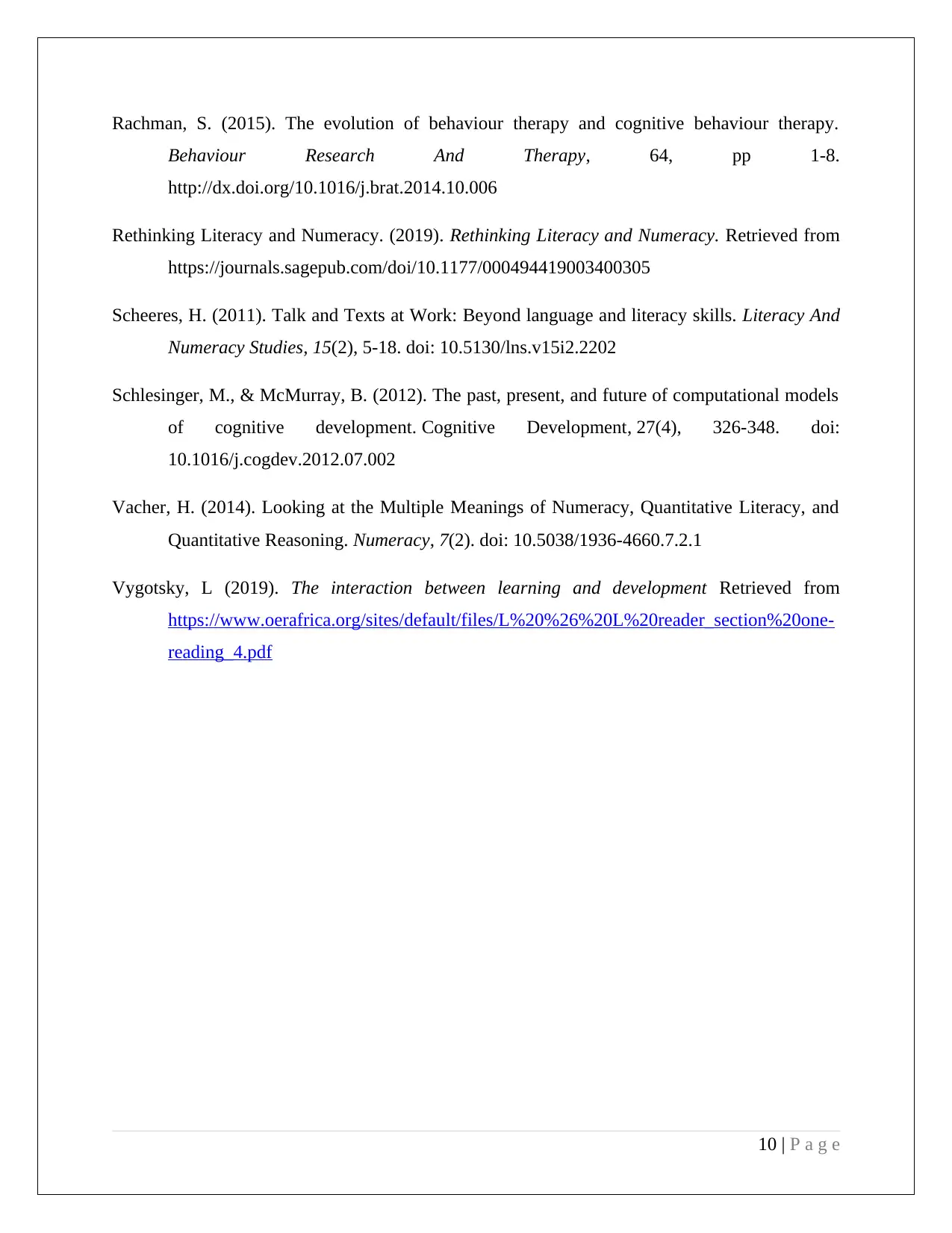
Rachman, S. (2015). The evolution of behaviour therapy and cognitive behaviour therapy.
Behaviour Research And Therapy, 64, pp 1-8.
http://dx.doi.org/10.1016/j.brat.2014.10.006
Rethinking Literacy and Numeracy. (2019). Rethinking Literacy and Numeracy. Retrieved from
https://journals.sagepub.com/doi/10.1177/000494419003400305
Scheeres, H. (2011). Talk and Texts at Work: Beyond language and literacy skills. Literacy And
Numeracy Studies, 15(2), 5-18. doi: 10.5130/lns.v15i2.2202
Schlesinger, M., & McMurray, B. (2012). The past, present, and future of computational models
of cognitive development. Cognitive Development, 27(4), 326-348. doi:
10.1016/j.cogdev.2012.07.002
Vacher, H. (2014). Looking at the Multiple Meanings of Numeracy, Quantitative Literacy, and
Quantitative Reasoning. Numeracy, 7(2). doi: 10.5038/1936-4660.7.2.1
Vygotsky, L (2019). The interaction between learning and development Retrieved from
https://www.oerafrica.org/sites/default/files/L%20%26%20L%20reader_section%20one-
reading_4.pdf
10 | P a g e
Behaviour Research And Therapy, 64, pp 1-8.
http://dx.doi.org/10.1016/j.brat.2014.10.006
Rethinking Literacy and Numeracy. (2019). Rethinking Literacy and Numeracy. Retrieved from
https://journals.sagepub.com/doi/10.1177/000494419003400305
Scheeres, H. (2011). Talk and Texts at Work: Beyond language and literacy skills. Literacy And
Numeracy Studies, 15(2), 5-18. doi: 10.5130/lns.v15i2.2202
Schlesinger, M., & McMurray, B. (2012). The past, present, and future of computational models
of cognitive development. Cognitive Development, 27(4), 326-348. doi:
10.1016/j.cogdev.2012.07.002
Vacher, H. (2014). Looking at the Multiple Meanings of Numeracy, Quantitative Literacy, and
Quantitative Reasoning. Numeracy, 7(2). doi: 10.5038/1936-4660.7.2.1
Vygotsky, L (2019). The interaction between learning and development Retrieved from
https://www.oerafrica.org/sites/default/files/L%20%26%20L%20reader_section%20one-
reading_4.pdf
10 | P a g e
1 out of 10
Related Documents
Your All-in-One AI-Powered Toolkit for Academic Success.
+13062052269
info@desklib.com
Available 24*7 on WhatsApp / Email
![[object Object]](/_next/static/media/star-bottom.7253800d.svg)
Unlock your academic potential
Copyright © 2020–2025 A2Z Services. All Rights Reserved. Developed and managed by ZUCOL.




